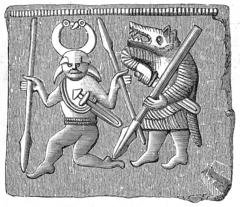Viking Berserkers
One of the most enduring aspects of the Viking Age is the legend of the Berserker and what little we know about them comes mainly from the Icelandic Sagas. The name Berserker has different etymologies with most scholars arguing that it means 'Bear Shirt' in Old Norse (Ber Sekr). However, the Icelandic historian Snorri Sturluson interpreted the Ber part as 'Bare', meaning the warrior fought without armour or protection.

Detail from the pre-Viking Age Torslunda helmet depicting a possible Berserker following a helmeted warrior (source: Wikipedia)
Whatever the origins of the name, the practise probably derived from hunting traditions and some authors have proposed that these men belonged to a Bear Cult which was spread across the northern hemisphere in antiquity. It seems that the berserks had a warrior tradition and code of practise similar the Japanese Bushido system, although how strict this was is unknown. The use of bears as symbols of military power go back to the Romans at least with depictions on Trajan's column of Germanic auxiliaries wearing bear and wolf skins. In modern times, bear skin caps are the feature some modern armies, the British and Danish monarch guards, for example.

Scene 36 detail from Trajan's Column depicting men wearing bearskins (source: http://arts.st-andrews.ac.uk)
The Viking berserks were famed for their fighting prowess and fits of frenzy in battle. They would howl like wild animals and gnaw the rims of their shields. They were supposedly immune to fire and steel during these fits and cut great swathes through the enemy's ranks. The act of going 'berserk' was 'Hamask' in Old Norse, which translates as 'change form'. It is not known what caused the men to go 'berserk' but theories about the use of drugs, such as hallucinogenic mushrooms or alcohol are the most likely. There is a strong possibility that other explanations such as mental illness, self induced hysteria, epilepsy or even genetics could have caused it. Possibly some of the men suffered from what is now called PTSD.

A Rook of the Lewis Chessmen set depicted as a possible Berserker biting his shield (source: Wikipedia)
Whatever the causes of the Berserk warrior's frenzy they have passed down through history as one of the most enigmatic features of the Viking Age. Frequently mentioned in Icelandic Sagas their legacy has continued through to modern day armies in the great bear warrior tradition.
Thank you for reading and please take a look at our catalogue, which includes this Viking Berserker design, click here for details: https://www.norsefury.com
